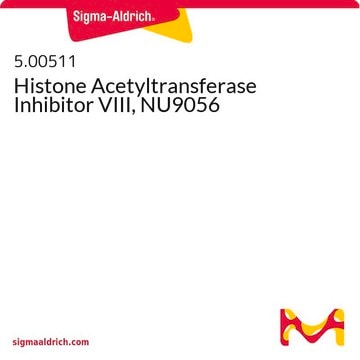C9873
CPTH2
≥98% (HPLC), powder
Sinonimo/i:
Cyclopentylidene-[4-(4-chlorophenyl)thiazol-2-yl)hydrazone
Scegli un formato
Scegli un formato
About This Item
Prodotti consigliati
Livello qualitativo
Saggio
≥98% (HPLC)
Stato
powder
Colore
white to beige
Solubilità
DMSO: >10 mg/mL
Temperatura di conservazione
2-8°C
Stringa SMILE
Clc1ccc(cc1)-c2csc(N\N=C3\CCCC3)n2
InChI
1S/C14H14ClN3S/c15-11-7-5-10(6-8-11)13-9-19-14(16-13)18-17-12-3-1-2-4-12/h5-9H,1-4H2,(H,16,18)
YYTHPXHGWSAKIZ-UHFFFAOYSA-N
Descrizione generale
Applicazioni
Azioni biochim/fisiol
Caratteristiche e vantaggi
Codice della classe di stoccaggio
11 - Combustible Solids
Classe di pericolosità dell'acqua (WGK)
nwg
Punto d’infiammabilità (°F)
Not applicable
Punto d’infiammabilità (°C)
Not applicable
Scegli una delle versioni più recenti:
Certificati d'analisi (COA)
Non trovi la versione di tuo interesse?
Se hai bisogno di una versione specifica, puoi cercare il certificato tramite il numero di lotto.
Possiedi già questo prodotto?
I documenti relativi ai prodotti acquistati recentemente sono disponibili nell’Archivio dei documenti.
I clienti hanno visto anche
Articoli
We offer a variety of small molecule research tools, such as transcription factor modulators, inhibitors of chromatin modifying enzymes, and agonists/antagonists for target identification and validation in gene regulation research; a selection of these research tools is shown below.
Filtri attivi
Il team dei nostri ricercatori vanta grande esperienza in tutte le aree della ricerca quali Life Science, scienza dei materiali, sintesi chimica, cromatografia, discipline analitiche, ecc..
Contatta l'Assistenza Tecnica.









